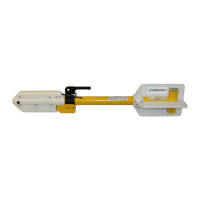Geometrics Inc. G-882 Cesium Marine Magnetometer Page 105
is right-hand polarized and the other left-hand polarized to minimize sensor
rotational light shifts and subsequent heading errors.
Once most of the Cesium atoms have absorbed photons and are in a state that
does not allow them to absorb another photon, the light absorption of the cell is
greatly reduced, i.e., more light hits the photo-detector. If an oscillating
electromagnetic field of the correct radio frequency is introduced into the cell, the
atoms will be driven back (depopulating the energy level) into an orientation that
will allow them to absorb photons again. This frequency is called the Larmor
frequency and is exactly proportional to the energy difference caused by the
Zeeman splitting mentioned previously. This energy splitting is in turn directly
proportional to the ambient magnetic field strength. The relationship between
frequency and energy is given by:
E = f
Where:
E is the Zeeman energy difference
f is the frequency of the Larmor
is Planck's constant
In Cesium this Larmor frequency is exactly 3.498572 times the ambient field
measured in nano-Teslas (gammas). In the G−882 this radio frequency field is
generated by a coil, called the H1 coil, wound around the tube holding the optical
components. When the RF field is present the total light passing through the cell
is reduced because atoms are in an energy state in which they can again absorb
the infrared light.
There is a small variation in the atomic light absorption at the frequency of the
applied H1 depopulation signal. This variation in light intensity appears on the
photo-detector as a small AC signal (microvolts). If this AC signal is amplified and
shifted to the correct phase, it can be fed back to the H1 coil to produce a self
sustaining oscillation. In practice simply connecting the 90° phase shifted and
amplified signal to the H1 coil will cause the oscillation to spontaneously start.
Reversing the direction of the earth field vector (H
0
) through the sensor requires
the drive to the H1 coil to be inverted to obtain oscillation. (See Automatic
Hemisphere Switching, section 2.4.3).

